AI-Powered HR Chatbots for Enhanced Processes and Engagement
Transform HR with AI chatbots to streamline onboarding, provide 24/7 support, and enhance employee engagement. Boost efficiency now!

Key Takeaways on AI-Powered HR Chatbots
- AI-powered HR chatbots automate routine HR workflows, offer 24/7 support, and elevate the employee experience through instant, personalized interactions.
- CandorIQ integration enables chatbots to deliver real-time compensation data, approval workflows, and headcount insights in one seamless experience.
- Key use cases include onboarding support, offer management, pulse surveys, compliance, and internal mobility.
- To measure impact, track metrics like query resolution rate, CSAT scores, time saved, and workforce planning alignment via CandorIQ dashboards.
HR teams are under growing pressure to deliver faster support, streamline workflows, and enhance the employee experience, all while maintaining a lean headcount. AI-powered HR chatbots automate repetitive tasks, deliver instant answers, and integrate across your HR tech stack to drive measurable improvements in operational efficiency and employee engagement, such as reduced response times and higher satisfaction scores.
We understand how challenging it can be for small, stretched HR and finance teams in fast-growing companies to manage complex compensation and workforce planning while keeping employees engaged and supported.
In this article, you’ll learn how chatbots are reshaping HR operations, which use cases deliver the biggest ROI, and how platforms like CandorIQ automate repetitive compensation and workforce planning workflows to boost productivity and employee satisfaction at scale.
What Is an AI-Powered HR Chatbot?
AI-powered HR chatbots use advanced technologies to understand your questions, learn from interactions to improve over time, and access up-to-date information to provide relevant answers and assist employees throughout their journey.
Key Capabilities That Set Them Apart
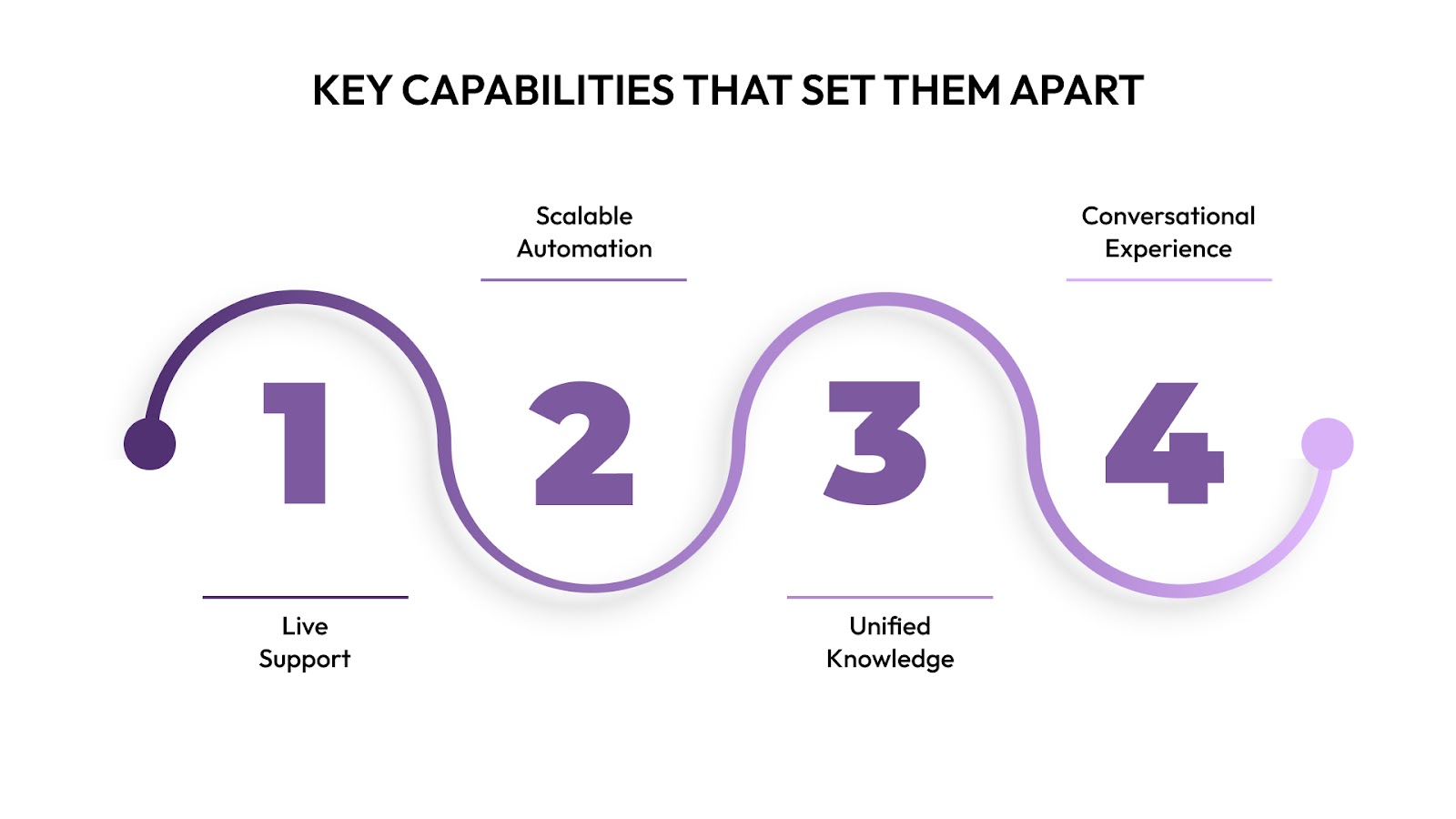
These chatbots stand out because they can quickly respond to employee questions, automate routine tasks like leave requests and approvals, pull information from various HR systems to provide accurate answers, and understand natural language to make conversations feel smooth and easy.:
- Real-Time Employee Support: Respond instantly to common HR queries, policies, benefits, and leave balances 24/7, without manual HR intervention.
- Process Automation at Scale: Trigger workflows like PTO applications, onboarding steps, or headcount approvals, reducing friction across functions.
- Integrated Knowledge Access: Pull from HRIS, ATS, payroll, and tools like CandorIQ to give role-based, contextually accurate answers on comp, promotions, and workflows.
- Conversational Experience: Understand and respond to nuanced, natural language queries, reducing the need for manual navigation of HR portals.
Why They Matter Now
Today’s hybrid and distributed teams expect fast, on-demand support, especially for time-sensitive topics like compensation, offer letters, or career progression. Relying on email chains or shared drives doesn’t cut it anymore.
AI-powered HR chatbots close this gap by offering:
- Faster onboarding and fewer HR bottlenecks
- Improved employee satisfaction and retention
- Reduced workload for HR and People Ops teams
When paired with CandorIQ, your HR chatbot becomes even more powerful by pulling in compensation structures, headcount forecasts, and approval workflows, enabling teams to access real-time pay band insights, open roles, or budget status directly through chat
Benefits of Chatbots in HR: Improving the Employee Experience
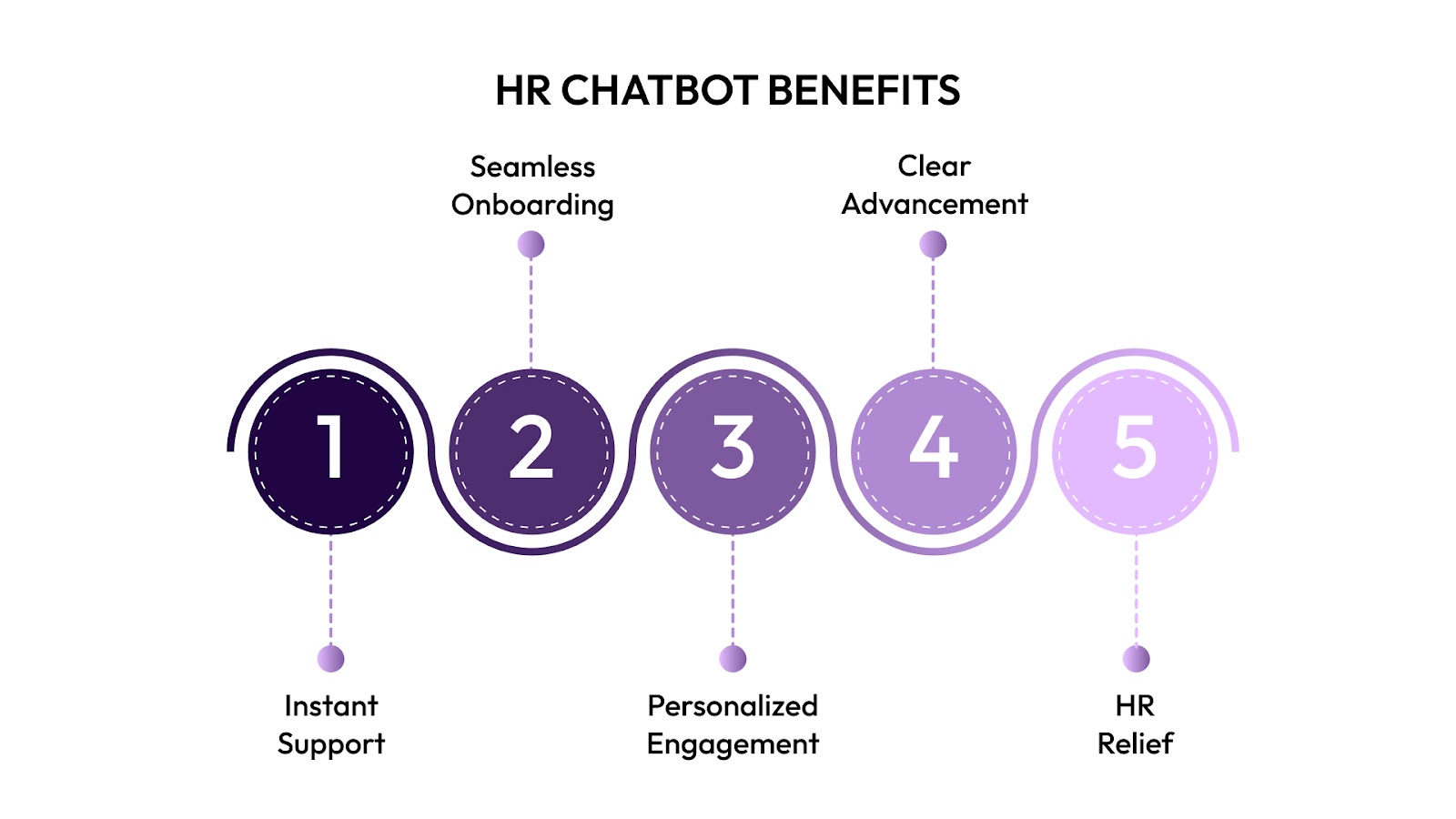
When your workforce is distributed, your HR team is stretched thin, and expectations for speed and personalization are high, AI chatbots in HR become essential. They not only automate processes but also improve the employee experience by making support more accessible, timely, and intuitive.
1. Always-On, Instant Support
Employees no longer need to wait for business hours or search through outdated FAQs.
- 24/7 accessibility empowers your team to get answers anytime, from onboarding documents to benefits clarifications.
- Chatbots resolve routine HR queries, such as leave balances, eligibility rules, and benefits enrollment timelines, instantly without human intervention.
- This responsiveness builds trust and reduces frustration by providing immediate, accurate answers during critical employee interactions.
2. Frictionless Onboarding and Transitions
First impressions matter. Whether it’s a new hire or a promotion, chatbots guide employees step-by-step.
- Share tailored onboarding checklists, benefits overviews, and training links directly in chat.
- Reduce onboarding time and minimize drop-offs in transition workflows through automated form fills, reminders, nudges, and real-time updates.
- Minimize drop-offs in transition workflows with nudges and real-time updates.
3. Boosted Engagement Through Personalization
AI chatbots aren’t generic, they adapt to role, location, and employee lifecycle stage.
- Trigger personalized nudges based on tenure, comp changes, or upcoming reviews.
- Run pulse checks and gather feedback without disrupting the flow of work.
- Collect sentiment data to flag disengagement early and support retention efforts.
4. Transparency Around Compensation and Growth
When integrated with platforms like CandorIQ, chatbots can do more than answer policy questions; they become strategic support tools.
- Show employees their total compensation (salary, equity, bonus, benefits) on demand.
- Provide clarity around pay bands, promotion timelines, and equity vesting, without going through HR.
- Support DEI by ensuring consistent, structured responses across the board.
5. Reduced Workload for HR Teams
The employee experience doesn’t improve by overburdening your HR team. AI-powered HR chatbots leverage natural language processing (NLP) to understand queries, apply machine learning to improve responses over time, and utilize real-time data integrations to provide contextual answers and guide employees effectively throughout their lifecycle.
- Enable self-service without compromising accuracy or context.
Why It Matters
A better employee experience leads to higher retention, productivity, and employer brand equity. By embedding AI-powered HR chatbots into your workflow, you enable every employee to feel supported, informed, and valued, at scale.
Core Use Cases of AI Chatbots in HR
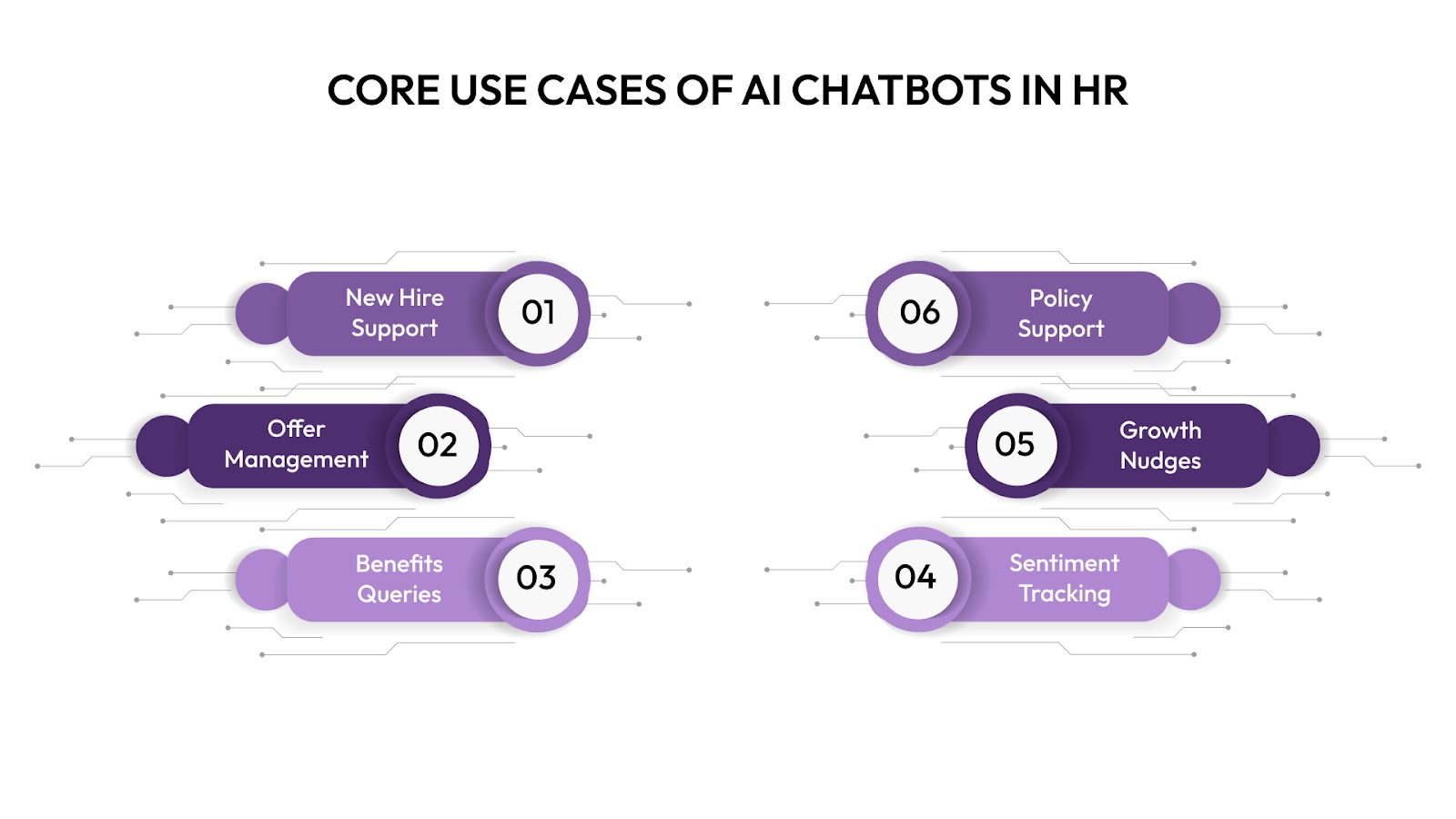
The true value of AI chatbots in HR lies in their ability to support both employees and HR teams across high-impact touchpoints, from pre-hire to offboarding. When thoughtfully deployed, these tools automate repetitive interactions, deliver personalized support, and ensure your workforce has consistent access to what they need, when they need it.
Here’s how they deliver measurable value across key HR functions:
1. Onboarding and New Hire Support
Onboarding sets the tone for an employee’s entire journey. A chatbot can guide new hires through each required step, providing clarity without burdening your HR team.
- Share personalized welcome kits, policies, benefits, and task checklists.
- Respond to frequently asked questions about tech setup, training schedules, and reporting lines.
- Reduce onboarding time and minimize drop-offs in transition workflows through automated form fills, reminders, nudges, and real-time updates.
2. Compensation & Offer Management
Integrating your chatbot with tools like CandorIQ unlocks smart compensation workflows and candidate clarity.
- Allow employees and candidates to view total rewards, including salary, equity, and bonuses, directly through chat.
- Deliver real-time answers about pay bands, promotion cycles, and eligibility.
- Guide managers during merit and bonus review cycles with comp insights and approval nudges.
This not only reduces the back-and-forth between HR and business leads but also ensures consistency and equity in decision-making.
3. Time-Off and Benefits Queries
Routine queries about PTO, leave policies, and insurance options can overwhelm HR teams, especially in distributed organizations.
- Automate approval workflows and sync data with your HRIS and payroll systems.
- Cut HR helpdesk volume, freeing your team for higher-value activities.
4. Pulse Checks and Sentiment Monitoring
Understanding how your employees feel before they submit a resignation is critical. AI chatbots can be a discreet and consistent listening tool.
- Conduct pulse surveys, quarterly check-ins, or post-project feedback via chat.
- Detect early signs of burnout, disengagement, or attrition risk based on sentiment and response patterns.
- Feed insights into platforms like CandorIQ to inform workforce planning and retention strategy.
5. Internal Mobility and Learning Nudges
Career development often stalls because of unclear processes. Chatbots simplify access to internal opportunities and resources.
- Surface open roles, learning programs, and performance goals personalized to each employee.
- Nudge employees toward upcoming review cycles, training deadlines, or mentorship openings.
- Promote a culture of growth while reducing dependency on HR follow-ups.
6. Policy Guidance and Compliance Support
When regulations change or new initiatives launch, consistent communication is vital to ensure compliance and avoid misunderstandings.
- Deliver policy updates across geographies with region-specific logic.
- Automate attestation workflows for compliance documentation.
- Reduce the risk of miscommunication that could lead to legal exposure or employee dissatisfaction.
By integrating AI chatbots with CandorIQ’s compensation and headcount planning tools, you create a unified experience where employees can explore their total comp, track promotion readiness, and understand workforce planning decisions, all through a single conversational interface.
Designing a Chatbot-Enabled HR Ecosystem
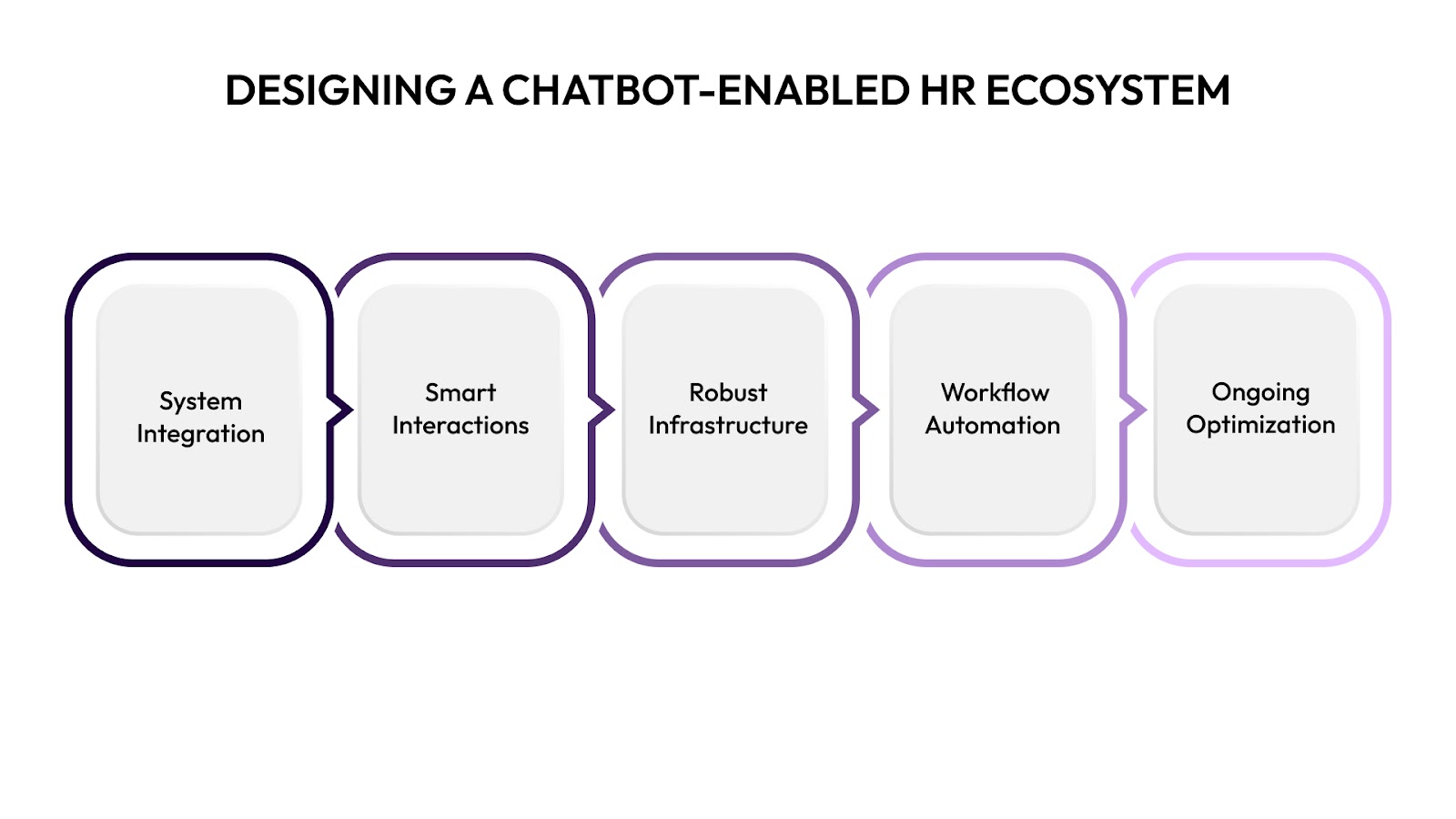
To get real ROI from AI chatbots in HR, you need more than just a chatbot; you need a thoughtfully connected ecosystem. A fragmented tech stack creates friction; an integrated one delivers speed, transparency, and data consistency. The goal is to embed the chatbot across your HR operations so it becomes a proactive partner, not just a reactive tool.
Here’s how to design an ecosystem that scales with your business:
1. Integrate with Your Core Systems of Record
Your chatbot is only as smart as the data it can access. Start by connecting it with your foundational systems:
- HRIS (for employee records and org structure)
- ATS (to support recruiting workflows and candidate experience)
- Payroll & Benefits (for compensation, tax, and benefits queries)
- Performance Management (for review cycles, feedback tracking)
- CandorIQ (for real-time compensation insights, pay band governance, and headcount planning)
2. Enable Contextual Conversations
Static bots frustrate users. Intelligent chatbots provide context-aware responses that adapt to role, location, tenure, and permissions.
- Show total comp breakdowns or raise eligibility based on pay band data from CandorIQ.
- Display region-specific leave policies and compliance updates.
- Offer personalized training reminders based on learning paths or performance goals.
The more relevant the experience, the more likely your employees are to engage and trust the system.
3. Secure, Scalable Architecture
Executives need confidence that employee data is safe and compliant.
- Ensure that the chatbot employs secure APIs alongside encrypted communication channels to protect sensitive employee data during all interactions.
- Set role-based access controls to prevent information leakage.
- Maintain a centralized audit trail of interactions for compliance and quality assurance.
4. Layer in Workflow Automation
Don’t stop at answering questions. Empower your chatbot to act.
- Trigger approval workflows for time off, compensation changes, or headcount requests.
- Push reminders for pulse surveys, benefits enrollment, or compliance sign-offs.
- Automate follow-ups, documentation, and task routing.
The result is reduced admin work and faster cycle times across HR functions.
5. Continuously Measure and Optimize
Your ecosystem should evolve based on usage patterns and business goals.
- Track query resolution rates, ticket deflection, and user satisfaction.
- Use CandorIQ dashboards to analyze HR interaction trends and workforce health.
- Refine chatbot scripts and integrations as your policies and priorities change.
A siloed chatbot is a short-term fix. But when embedded into a connected HR ecosystem, anchored by tools like CandorIQ, it becomes a strategic asset. It reduces manual overhead, increases employee autonomy, and helps HR become a proactive force in business growth.
Measuring Chatbot Impact
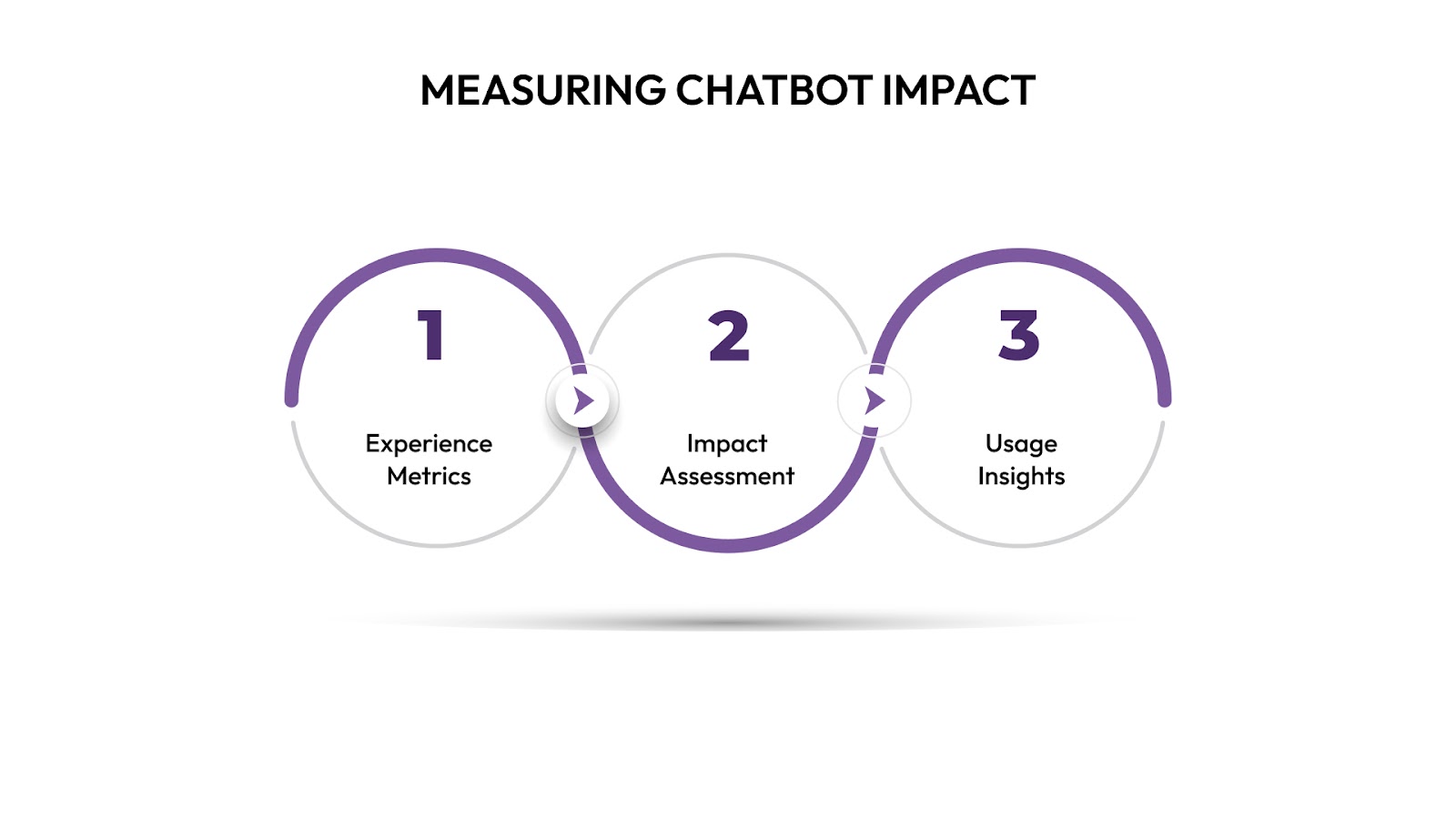
Deploying an AI chatbot for HR is the starting point for continuous optimization. To justify the investment and guide future decisions, you need to track performance against well-defined KPIs that align with your broader HR and business goals.
Here’s how to measure the impact of your chatbot in a way that drives strategic outcomes:
The first lens is productivity, how much time and cost your chatbot saves across HR operations.
Key Metrics to Monitor:
- Query resolution rate: What percentage of routine HR queries are resolved by the chatbot without escalation?
- Time saved per query: Automating benefits, leave, or policy questions can save significant time per request.
- Reduction in ticket volume: Companies using HR chatbots have reported fewer support tickets to HR helpdesks.
This frees your HR team to focus on strategic initiatives like compensation governance, DEI efforts, and workforce planning.
2. Measure Employee Experience Improvements
A smarter HR chatbot does more than automate; it improves the employee experience at key touchpoints.
Data Points to Capture:
- First-response time: Instant support 24/7 vs. waiting hours or days for a reply.
- CSAT (Chat Satisfaction) scores: Use quick post-chat surveys to capture satisfaction levels.
- Onboarding engagement rates: Track completion time and drop-offs when the chatbot supports new hire journeys.
- Sentiment trends: Integrate with engagement surveys to compare satisfaction pre- and post-chatbot rollout.
3. Evaluate Business-Level Impact
Your HR chatbot’s value should ladder up to measurable business KPIs.
Strategic KPIs to Monitor:
- Attrition rate changes: Use chatbot engagement data with CandorIQ to correlate early signals with turnover trends.
- Offer acceptance rate: Real-time comp queries and offer breakdowns can boost candidate conversion.
- Time-to-resolution for HR actions: Speed up headcount requests, offer approvals, or policy sign-offs by automating follow-ups.
- Manager satisfaction: Survey business leaders on how chatbots support decision-making (especially in comp and planning cycles).
4. Review Adoption and Utilization Patterns
Engagement data tells you whether your chatbot is integrated into day-to-day workflows or simply ignored.
Metrics to Watch:
- Daily/weekly active users,
- Most common queries by category,
- Unanswered or escalated queries (to improve scripts),
- Usage by department or region.
Feed this data back into your CandorIQ dashboards to align chatbot usage with workforce trends, compensation patterns, or headcount shifts.
Measuring impact is about guiding smarter evolution. By aligning metrics with organizational goals and integrating with platforms like CandorIQ, you ensure your AI-powered HR chatbot doesn’t just support HR but scales it.
Roadmap to Launch with CandorIQ
Launching an AI chatbot for HR is about activating a smarter, faster, and more connected HR function. CandorIQ provides a structured path to implementation that minimizes disruption, accelerates value, and ensures strategic alignment across HR and Finance.
Here’s how to roll out a chatbot-powered HR experience using CandorIQ’s intelligent platform:
1. Define Strategic Use Cases and Goals
Start by anchoring your chatbot initiative in specific, measurable objectives. With CandorIQ, you can focus on high-impact outcomes such as:
- Reducing HR ticket volume by automating top queries (e.g., leave policy, total comp visibility).
- Improving offer clarity and candidate engagement through chatbot-assisted compensation modeling.
- Accelerating headcount approval cycles via automated workflow triggers.
2. Connect Data Sources for Unified Intelligence
For your chatbot to deliver real-time, relevant answers, it needs access to accurate data. CandorIQ integrates with:
- HRIS platforms (employee records, job architecture).
- ATS tools (candidate status, approvals).
- Payroll and benefits systems (compensation details, deductions).
- Finance platforms (budget thresholds, forecast data).
A single source of truth for chatbot logic, reducing fragmentation and duplication across systems.
3. Configure Chatbot Workflows Around Existing HR Processes
CandorIQ enables you to build chatbot workflows that match your real-world operations:
- Set rules for pay band logic and escalation paths for compensation queries
- Enable auto-triggers for headcount request approvals and policy FAQs
- Customize role-based visibility (e.g., what managers see vs. what employees can access).
This ensures your chatbot doesn’t just answer questions; it drives execution and compliance.
4. Train, Pilot, and Refine
Before full deployment, run a pilot with key internal users (HRBPs, recruiters, finance leads):
- Collect feedback on usability, clarity, and accuracy of responses.
- Identify and fill gaps in data flow or logic.
- Refine workflows and permissions based on real usage.
5. Launch in Phases and Monitor Performance
CandorIQ recommends a phased rollout to maximize adoption and minimize resistance:
- Phase 1: Internal HR team
- Phase 2: Manager-level users
- Phase 3: Company-wide deployment
Post-launch, track engagement metrics, resolution rates, and alignment with workforce goals, then iterate.
Why CandorIQ is Different
Unlike point-solution chatbots, CandorIQ’s AI-powered capabilities sit at the intersection of compensation governance, headcount planning, and HR automation. You get:
- Workflow-integrated automation.
- Real-time comp data embedded into chatbot interactions.
- Cross-functional alignment with Finance, IT, and HR teams.
A chatbot-led HR experience that’s not just efficient, but intelligent, scalable, and fully aligned with your strategic workforce plans.
Conclusion
AI-powered HR chatbots are a competitive advantage. When integrated thoughtfully, they reduce friction, accelerate workflows, and elevate the employee experience across the board. From onboarding to compensation transparency and policy queries, the right chatbot drives value.
CandorIQ equips your HR and finance teams with real-time decision support, automated workflows, and deep compensation intelligence, all without the need for additional headcount or siloed chatbots.
Ready to modernize your HR-Finance collaboration? Book a CandorIQ demo and see how intelligent compensation agents transform your workflows.


